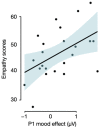In a Bilingual Mood: Mood Affects Lexico-Semantic Processing Differently in Native and Non-Native Languages
- PMID: 35326272
- PMCID: PMC8945979
- DOI: 10.3390/brainsci12030316
In a Bilingual Mood: Mood Affects Lexico-Semantic Processing Differently in Native and Non-Native Languages
Abstract
Positive and negative moods tend to have differential effects on lexico-semantic processing in the native language (L1). Though accumulating evidence points to dampened sensitivity to affective stimuli in the non-native language (L2), little is known about the effects of positive and negative moods on L2 processing. Here, we show that lexico-semantic processing is differently affected by positive and negative moods only in L1. Unbalanced Polish-English bilinguals made meaningfulness judgments on L1 and L2 sentences during two EEG recording sessions featuring either positive- or negative-mood-inducing films. We observed a reduced N1 (lexical processing) for negative compared to positive mood in L2 only, a reduced N2 (lexico-semantic processing) in negative compared to positive mood in L1 only, a reduced N400 (lexico-semantic processing) for meaningless compared to meaningful L1 sentences in positive mood only, and an enhanced late positive complex (semantic integration and re-analysis) for L2 compared to L1 meaningful sentence in negative mood only. Altogether, these results suggest that positive and negative moods affect lexical, lexico-semantic, and semantic processing differently in L1 and L2. Our observations are consistent with previous accounts of mood-dependent processing and emotion down-regulation observed in bilinguals.
Keywords: bilingualism; emotion regulation; event-related potentials; lexico-semantic processing; meaning integration; mood.
Conflict of interest statement
The authors declare no conflict of interest. The funders had no role in the design of the study; in the collection, analyses, or interpretation of data; in the writing of the manuscript, or in the decision to publish the results.
Figures











Similar articles
-
Native and non-native language contexts differently modulate mood-driven electrodermal activity.Sci Rep. 2022 Dec 26;12(1):22361. doi: 10.1038/s41598-022-27064-3. Sci Rep. 2022. PMID: 36572782 Free PMC article.
-
Positive and negative moods differently affect creative meaning processing in both the native and non-native language.Brain Lang. 2022 Dec;235:105188. doi: 10.1016/j.bandl.2022.105188. Epub 2022 Oct 12. Brain Lang. 2022. PMID: 36242817
-
Language switching is modulated by emotion priming: evidence from behavioral and event-related potentials study.Front Psychol. 2024 Dec 2;15:1373636. doi: 10.3389/fpsyg.2024.1373636. eCollection 2024. Front Psychol. 2024. PMID: 39687565 Free PMC article.
-
Bilingual language processing: A meta-analysis of functional neuroimaging studies.Neurosci Biobehav Rev. 2020 Jan;108:834-853. doi: 10.1016/j.neubiorev.2019.12.014. Epub 2019 Dec 12. Neurosci Biobehav Rev. 2020. PMID: 31838193 Review.
-
Affective processing in bilingual speakers: disembodied cognition?Int J Psychol. 2012;47(6):405-28. doi: 10.1080/00207594.2012.743665. Int J Psychol. 2012. PMID: 23163422 Review.
Cited by
-
Mood effects on semantic processes: Behavioural and electrophysiological evidence.Front Psychol. 2022 Nov 11;13:1014706. doi: 10.3389/fpsyg.2022.1014706. eCollection 2022. Front Psychol. 2022. PMID: 36438367 Free PMC article. Review.
-
Electrophysiological evidence of lexical processing impacted by foreign language reading anxiety.Heliyon. 2024 Apr 25;10(9):e30061. doi: 10.1016/j.heliyon.2024.e30061. eCollection 2024 May 15. Heliyon. 2024. PMID: 38720696 Free PMC article.
-
Language Nativeness Modulates Physiological Responses to Moral vs. Immoral Concepts in Chinese-English Bilinguals: Evidence from Event-Related Potential and Psychophysiological Measures.Brain Sci. 2023 Nov 2;13(11):1543. doi: 10.3390/brainsci13111543. Brain Sci. 2023. PMID: 38002503 Free PMC article.
-
Comprehending scientific metaphors in the bilingual brain: Evidence from event-related potentials.Front Psychol. 2022 Dec 6;13:1037525. doi: 10.3389/fpsyg.2022.1037525. eCollection 2022. Front Psychol. 2022. PMID: 36578691 Free PMC article.
-
Native and non-native language contexts differently modulate mood-driven electrodermal activity.Sci Rep. 2022 Dec 26;12(1):22361. doi: 10.1038/s41598-022-27064-3. Sci Rep. 2022. PMID: 36572782 Free PMC article.
References
-
- Grosjean F. Bilingual: Life and Reality. Harvard University Press; Cambridge, MA, USA: London, UK: 2010. - DOI
-
- Jończyk R. Affect-Language Interactions in Native and Non-Native English Speakers. Springer International Publishing; Cham, Switzerland: 2016. - DOI
-
- Naranowicz M., Jankowiak K., Bromberek-Dyzman K. Mood and gender effects in emotional word processing in unbalanced bilinguals. Int. J. Biling. 2022 in press .
Grants and funding
LinkOut - more resources
Full Text Sources

